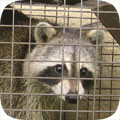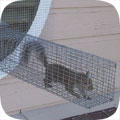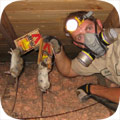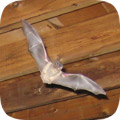- cheyenne@wildlifeanimalcontrol.com
Call 24/7 for a free quote:
307-274-4615
Cheyenne Wildlife Animal Control
Professional Wildlife Removal Company Servicing Cheyenne, WY
If you have a problem with wildlife in your Cheyenne home, your best option is to hire a company that specializes in Wyoming wildlife removal only. This is a specialty business, and regular pest control companies do not use the proper techniques to solve animal problems. I have spent many years reviewing Wyoming and Cheyenne, and I recommend the following:
Cheyenne Wildlife Removal
Cell Phone: 307-274-4615
NOTE: If you have a dog or cat problem, call Laramie County Animal Services: (307) 632-6655

Cheyenne Wildlife Removal specializes primarily in removing animals from attics of homes and buildings - this includes squirrels in attics, raccoons, and rats or mice in homes. Wyoming also has a documented problem with
bats in buildings, and Cheyenne Wildlife Removal is specially trained in bat removal. They also perform general wildlife trapping services, such as the capture and removal of skunks or opossums on the
property. Call 307-274-4615 to discuss your critter problem and schedule a same-day or next-day appointment. Click here to learn more about what prices we charge in 2020.
When hiring a company to solve your wild animal problem, you want these features:
- Specializes in wildlife removal, not pest control
- Fully Wyoming and Laramie County licensed and insured
- Works 7 days per week (critters don't take weekends off)
- Performs full building inspections: enters and inspects attic
- Performs exclusion repairs, with guarantee against animal re-entry
- Offers cleanup of biohazardous wildlife waste
Cheyenne Wildlife Removal is a full-service Cheyenne wildlife removal company. This is very different from a regular Cheyenne pest control company. The pest control companies spray poison to kill insects. This is not at all
similar to wildlife removal. Cheyenne Wildlife Removal performs a full inspection of the home or property, and determines why the animal(s) are there, and if inside a building, how the animals got inside. All
animals (including rodents) are trapped and removed, or if possible, removed from the building using special exclusion devices. Once the animals are gone, preventative repairs are essential, and
cleanup is sometimes recommended.
 Cheyenne wildlife trapping - it's not as simple as it may seem. It's illegal in Wyoming to trap without a license. Trap type is very important and there are many different types, bait is somewhat relevant, trap placement
is vital, and there are dozens of small things that are very important to know.
Safety is a concern. Then once the animal is trapped, it must be removed and dealt with in the proper manner according to Wyoming law. We offer Cheyenne raccoon removal. Read more about how to get rid of raccoons.
Cheyenne wildlife trapping - it's not as simple as it may seem. It's illegal in Wyoming to trap without a license. Trap type is very important and there are many different types, bait is somewhat relevant, trap placement
is vital, and there are dozens of small things that are very important to know.
Safety is a concern. Then once the animal is trapped, it must be removed and dealt with in the proper manner according to Wyoming law. We offer Cheyenne raccoon removal. Read more about how to get rid of raccoons.
 Animals in attics - this is our specialty at Cheyenne Wildlife Removal. Many types of animals like to live in attics. This includes squirrels, raccoons, rats, mice, bats, birds, and even possums. Critters like to go into attics for a safe place to live
and raise their young. Removing animals from attics is very complex work, partly because of the presence of baby animals. If you need Cheyenne squirrel removal, we can remove all the squirrels from your attic, and seal out any future ones. Read more about how to get rid of squirrels.
Animals in attics - this is our specialty at Cheyenne Wildlife Removal. Many types of animals like to live in attics. This includes squirrels, raccoons, rats, mice, bats, birds, and even possums. Critters like to go into attics for a safe place to live
and raise their young. Removing animals from attics is very complex work, partly because of the presence of baby animals. If you need Cheyenne squirrel removal, we can remove all the squirrels from your attic, and seal out any future ones. Read more about how to get rid of squirrels.
 Rodent control must be done in a very specific way. First off, the most important thing is that all the openings that rats and mice can use to enter a house be sealed. Then all the rodents must be physically trapped and removed.
Never, ever use poison! Most Cheyenne exterminators will just use this lazy poison technique to kill rodents, and it causes more harm than good - dead stinky rats, and it doesn't solve the problem. Call us for correct Cheyenne rat removal. Read more about how to get rid of rats.
Rodent control must be done in a very specific way. First off, the most important thing is that all the openings that rats and mice can use to enter a house be sealed. Then all the rodents must be physically trapped and removed.
Never, ever use poison! Most Cheyenne exterminators will just use this lazy poison technique to kill rodents, and it causes more harm than good - dead stinky rats, and it doesn't solve the problem. Call us for correct Cheyenne rat removal. Read more about how to get rid of rats.
 Bat removal is a highly specialized task. Wyoming is known to have colonizing bats who often live in buildings. Bats love attics. If not removed, the colony can grow to a very large size over the years. The bat droppings are often corrosive and
cause health risks. The same goes for bird droppings on or in buildings. We perform Cheyenne pigeon removal and bird control. But our specialty is Cheyenne bat removal. We remove 100% of the bat colony and seal the building so that it's totally bat-proof. Read more about how to get rid of bats.
Bat removal is a highly specialized task. Wyoming is known to have colonizing bats who often live in buildings. Bats love attics. If not removed, the colony can grow to a very large size over the years. The bat droppings are often corrosive and
cause health risks. The same goes for bird droppings on or in buildings. We perform Cheyenne pigeon removal and bird control. But our specialty is Cheyenne bat removal. We remove 100% of the bat colony and seal the building so that it's totally bat-proof. Read more about how to get rid of bats.
 If you have animals inside a house, no job is complete without proper exclusion repairs. If you simply hire a Cheyenne trapper who only removes the critters, then the problem will return. You need to hire a Cheyenne wildlife control company that identifies 100% of the animal entry points
into your building, and seals them shut with professional repairs. In addition, in many cases animals have left waste or contamination behind, and you'll want a company that can provide professional cleaning services. Cheyenne Wildlife Removal does both.
If you have animals inside a house, no job is complete without proper exclusion repairs. If you simply hire a Cheyenne trapper who only removes the critters, then the problem will return. You need to hire a Cheyenne wildlife control company that identifies 100% of the animal entry points
into your building, and seals them shut with professional repairs. In addition, in many cases animals have left waste or contamination behind, and you'll want a company that can provide professional cleaning services. Cheyenne Wildlife Removal does both.
The above are just some of the services offered by Cheyenne Wildlife Removal. We also trap and remove animals that destroy lawns, such as moles, or digging animals. Sometimes animals like opossums will live under buildings, steal pet food, raid garbage cans, etc.
Read about how to get rid of opossums. Skunks commonly live under sheds or decks, and set up a den. We can trap and remove them without them spraying. Read about how to get rid of skunks. Cheyenne Wildlife Removal
also provides dead animal removal in Cheyenne. If you need help with any other wildlife conflict, from a fox, beaver, groundhog, or any other critter, we can solve it. We also do Cheyenne snake removal - most of the snakes in Wyoming are not venomous, but
call us if you want safe removal, or read about how to get rid of snakes in Cheyenne. And remember, we are a private business, not Laramie County Animal Control Services, so if you have a dog or cat problem, call the County at (307) 632-6655.
Laramie County animal services does not handle any wildlife issues.
Cheyenne Wildlife Removal: 307-274-4615
Cheyenne Pricing Info For Year 2020
 Every wildlife removal situation is different, from the species of animals involved, the location of the animal inside a house or outside, the extent of repairs or cleanup, etc. It's impossible to give one-size-fits-all prices. Examples MIGHT include:
Every wildlife removal situation is different, from the species of animals involved, the location of the animal inside a house or outside, the extent of repairs or cleanup, etc. It's impossible to give one-size-fits-all prices. Examples MIGHT include:
Small Job: For example, a one-stop job to remove an animal in the yard: $100 on up
Medium Job: For example, getting critters out of your house with minor repairs: $300 on up
Large Job: For example, a project involving many service trips and complex work: $500 on up
Give us a phone call now and tell us about your wildlife issue and we will be able to give you a price estimate over the phone. If you're cool with it, we can schedule a same-day or next-day appointment if you like. Our prices are fair, and a good value because we do the job right, the first time.
Cheyenne Wildlife Tip #1:
How to trap a fox
Trapping foxes can be a very difficult task for people who have not done it before. However, it is very easy and cheap to trap a live fox. There are two types of traps that can be used; hole-traps and cage traps.
Cage traps
These are the easiest to use as they only require some knowledge about the foxes to be trapped, the trap and also some patience. The first thing to do is to buy a cage trap. They are made of steel to make them strong and also to prevent them from rusting. Buy the size that can hold a fully grown dog, since foxes are almost the same size as dogs.
Buying some bait is the second most important task. You need to ensure that you acquire the right type of bait to attract the foxes to the traps. You can use cat food, a rodent or any other food materials with a scent of fish.
Place the bait in the trap so that the fox has to be wholly into the trap to feed on it. If the foxes can take a bite without getting inside the trap, then there are chances that they will eat the bait without getting trapped. Do not use too much bait since you just need to lure the fox into the trap.
To capture any foxes, you have to ensure that the trap is placed on a place where they pass through. If you place a trap far away from their usual path, then you reduce your chances of catching a fox. Placing the trap on a known fox route and using sweet-smelling bait are two ways to ensure that a fox gets into your trap.
Using cage traps needs a lot of patience since foxes move around in the night. There are more chances of trapping a fox in the night than there are during the day.
Use of ground holes
This are the oldest traps used to catch animals. All you need is a hole in the ground and very smelly bait and you can be assured that a fox will enter into the trap. Just ensure that the hole is deep enough for it to hold the fox without the chances of it jumping out as it tries to escape. For safety purposes, it is also advised that you put a weak covering that will disguise the hole as normal ground. If you have used good bait, then you can be assured that you will catch a fox or two. However, you should use this method far away from children as they could get injured if they fell into these ditches.
Cheyenne Wildlife Tip #2:
DO COYOTES REALLY MAKE GOOD PETS?
Web have to blame it on the Bambi syndrome(a disorder where rational thought is thrown out the window) narcissism, novelty, agression or cuteness. Whichever your pick is, it definitely has an impact on the increasing number of coyotees being brought into peoples homes as pets. Although highly unconventional , it is not impossible to own a coyote. For $8000 you can import one of these furry creatures into your home from Russia,which pioneeered domestication of wild coyotes so that they could be easy to handle in their fur industry. Domestication, is not the same as taming- domestication is breeding of specific genetic characteristics while taming is just conditioned behaviour. This is the kind of information you would need to know if planning to acquire a coyote for a pet.
The Russian variety(the silver coyote), after selective breeding of about forty generations has produced a strain of coyotes that are very similar to dogs in behavioural traits and partly their appearance except they are still coyotes-just not wild, which is very good news to pet lovers. However, there are a number of considerations to determine just how well coyotees are suited to be pets.
Unlike dogs,coyotes cannot be trained to perform tricks. Granted, they can obey certain commands but they naturally have a short attention span which makes teaching them tricks really challenging. Just like other pets, you would need to pet-proof your home so that they dont ruin furniture or drapes with their nails or their nasty smelling urine.
They are definitely not for everyone. If you are allergic to other animals then coyotees are probably not an exception. Coyotes need special attention- first, you would need to find a good vet who has experience in dealing with coyotees and if you cannot then there goes your dream pet. They need to be brushed regularly as they shed heavily during summer. They also need special outdoor enclosures that allow them enough room for playing and digging as coyotes have a stronger impulse for digging than dogs.
Coyotes are also considered rabies factors so unless you are willing to take the risk then it would be advisable to keep them away from your home and especially other pets.
On the plus side, they do not need regular baths as that is harmful to their skin. However, they need to be maintained clean with clipped nails and flea-free fur. They are also omnivorous which is an advantage as they can eat a large variety of foods but steer clear of those that would make your other pets sick. Most importantly, make sure the law in your area of residence allows for exotic pets to avoid trouble with animal control.
Wyoming Wildlife Information:
You can always call Cheyenne Wildlife Removal, any time of day, at 307-274-4615, for a price quote for Cheyenne wildlife control services. I am confident that this is the best choice amongst wildlife removal companies in Cheyenne, WY.





































